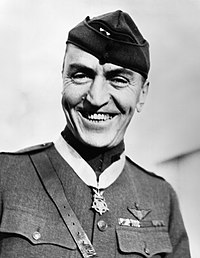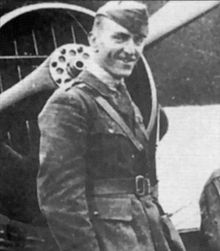This cache is one in a series placed by the Military Association of GeoCachers - Northern Virginia Chapter (MAGC-NoVA) to honor recipients of the Congressional Medal Honor (CMOH). The CMOH is the highest award that a member of the U.S. military can receive. For more information on the medal, go to this link: http://www.cmohs.org/medal-history.php.
The cache is along a bike/walking path. The difficulty rating reflects the stealth required. Neighborhood street parking is available.
 Best Theme/Series!
Best Theme/Series!
++++++++++++++++++++++++++++++++

Edward Vernon Rickenbacker (October 8, 1890 – July 23, 1973) was an American fighter ace in World War I and Medal of Honor recipient. With 26 aerial victories, he was America's most successful fighter ace in the war. He was also considered to have received the most awards for valor by an American during the war. He was also a race car driver and automotive designer, a government consultant in military matters and a pioneer in air transportation, particularly as the long-time head of Eastern Air Lines.
Edward Rickenbacker was born in Columbus, Ohio, to Swiss German-speaking immigrants. From childhood, he loved machines and experimented with them, encouraged by his father's words: "A machine has to have a purpose".
In what was to become one of the defining characteristics of Rickenbacker's life, he nearly died many times in events ranging from an early run-in with a horse-drawn carriage, to a botched tonsillectomy, to airplane crashes. His first life-threatening experience occurred when he was in the "Horsehead Gang". He lived near a mine, and they decided to ride a cart down the slope. It tipped over and almost crushed them.
Army service

Image of Eddie Rickenbacker in A Concise History of the U.S. Air Force by Stephen L. McFarland.
When, in 1917, the United States declared war on Germany, Rickenbacker had enlisted in the United States Army and was soon training in France with some of the first American troops. He arrived in France on June 26, 1917, as a Sergeant First Class.
Most men chosen for pilot training had college degrees and Rickenbacker had to struggle to gain permission to fly because of his perceived lack of academic qualifications. Because of his mechanical abilities, Rickenbacker was assigned as engineering officer at the 3rd Aviation Instruction Center at Issoudun, the US Air Service's pursuit training facility, where he practiced flying during his free time. He learned to fly well, but because his mechanical skills were so highly valued, Rickenbacker's superiors tried to prevent him from attaining his wings with the other pilots.
Rickenbacker demonstrated that he had a qualified replacement, and the military awarded him a place in one of America's air combat units, the 94th Aero Squadron, informally known as the "Hat-in-the-Ring" Squadron after its insignia. Originally he flew the Nieuport 28, at first without armament. On April 29, 1918, Rickenbacker shot down his first plane. On May 28, he claimed his fifth to become an ace. Rickenbacker was awarded the French Croix de Guerre that month for his five victories.
On May 30, he scored his sixth victory. It would be his last for three and a half months. He developed an ear infection in July which almost ended his flying career and grounded him for several weeks. He shot down Germany's new fighter, the Fokker D.VII, on September 14, and another the next day.
On September 24, 1918, now a captain, he was named commander of the squadron, and on the following day, he claimed two more German planes, for which he was belatedly awarded the Medal of Honor in 1931 by President Herbert Hoover. After claiming yet another Fokker D.VII on September 27, he became a balloon buster by downing observation balloons on September 28, October 1, October 3, October 27, and October 30, 1918.
Thirteen more wins followed in October bringing his total to thirteen Fokker D.VIIs, four other German fighters, five highly defended observation balloons, and only four of the easier two-seated reconnaissance planes.
The military determined ace status by verifying combat claims by a pilot, but confirmation, too, was needed from ground witnesses, affirmations of other pilots, or observation of the wreckage of the opposing enemy aircraft. If no witnesses could be found, a reported kill was not counted. It was an imperfect system, dependent on the frailties of human observation, as well as vagaries of weather and terrain. Most aces' records are thus 'best estimates', not 'exact counts'. Nevertheless, Rickenbacker's 26 victories remained the American record until World War II.
Rickenbacker flew a total of 300 combat hours, reportedly more than any other U.S. pilot in the war.
When Rickenbacker learned of the Armistice, he flew an airplane above the western front to observe the ceasefire and the displays of joy and comradeship, as the formerly warring troops crossed the front lines and joined in the celebrations.
Rickenbacker was awarded the Distinguished Service Cross a record eight times. One of these awards was converted in 1930 to the Medal of Honor. He was also awarded the Legion of Honor and the Croix de Guerre by France.
MEDAL OF HONOR CITATION:
For conspicuous gallantry and intrepidity above and beyond the call of duty in action against the enemy near Billy, France, September 25, 1918. While on a voluntary patrol over the lines Lt. Rickenbacker attacked seven enemy planes (five type Fokker protecting two type Halberstadt photographic planes). Disregarding the odds against him he dived on them and shot down one of the Fokkers out of control. He then attacked one of the Halberstadts and sent it down also.
[https://en.wikipedia.org/wiki/Eddie_Rickenbacker ]